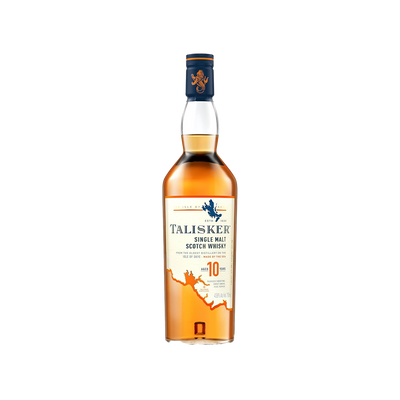Island Single Malt
What is Island Single Malt?
Island Single Malt represents a distinctive category of Scotch Whisky produced on Scotland's remote islands, including Islay, Skye, Orkney, Jura, Arran, and Mull. These whiskies are defined by their coastal influence, often showcasing maritime character with notes of sea salt, smoke, and peat that reflect their island terroir. Each island brings its own personality to the glass, from Islay's legendary peat monsters to Orkney's honeyed complexity, making Island Single Malts some of the most distinctive and sought-after expressions in the whisky world.
Learn More About Island Single Malt
What makes Island Single Malt unique?
Island Single Malts stand apart from other Scotch whiskies through their distinctive maritime character, shaped by coastal maturation that infuses sea salt, brine, and oceanic minerals into every dram. Unlike the heavily peated Islay malts or the honeyed Speyside expressions, Island whiskies offer a middle ground where gentle peat smoke mingles with fresh sea air and coastal herbs, creating a complexity that's both approachable and wildly expressive. Each island—from Skye's rugged intensity to Orkney's heather-sweetened profiles—brings its own microclimate and local ingredients to the whisky, making this category one of Scotland's most geographically diverse and personality-driven.
How is Island Single Malt made?
Island Single Malt whisky follows the same fundamental process as other Scotch single malts—malted barley is mashed, fermented with yeast, and distilled twice in copper pot stills before aging in oak casks for at least three years. What makes these whiskies distinct is how each island's unique environment shapes the production: Islay distilleries often use heavily peated malt and age their whisky in coastal warehouses where sea spray influences maturation, while islands like Skye and Orkney might use lighter peat levels and benefit from different coastal conditions. The combination of local water sources, varying peat usage, and maritime aging conditions gives each island's single malts their characteristic personality.
How do you drink Island Single Malt?
Island Single Malt Scotch whisky is traditionally enjoyed neat or with just a splash of water to open up its complex maritime flavors—the salt spray, peat smoke, and coastal character shine brightest when undiluted. While purists prefer it straight, it also works beautifully on the rocks, where the gradual dilution reveals different flavor layers as the ice melts. When it comes to cocktails, Island malts excel in spirit-forward drinks like Old Fashioneds or Blood and Sand variations, where their bold, smoky personality can stand up to other strong ingredients without getting lost in the mix.
How do I choose good Island Single Malt?
Start by considering which island style appeals to you most—Islay's famous peat smoke and medicinal notes, Orkney's honeyed complexity, or the lighter maritime character from islands like Skye or Mull. If you're planning to mix cocktails, lean toward whiskies with bold, distinctive flavors like Ardbeg or Lagavulin that can stand up to other ingredients, while gentler expressions like Highland Park work beautifully neat or with just a splash of water. Your best bet is to try before you buy when possible, since island malts vary dramatically in intensity and flavor profile even within the same distillery.
Nutritional Information
Typical Calorie Range per Ounce: 64-70 calories
Typical Carbohydrate Range per Ounce: 0-0.1 grams
Typical Sugar Range per Ounce: 0 grams
Typically Gluten Free: No
Island Single Malt Scotch whisky is made from malted barley, which contains gluten. While the distillation process may remove some gluten proteins, most celiac organizations recommend avoiding barley-based spirits. Those with gluten sensitivities or celiac disease should always check detailed product information and consult with healthcare providers before consumption, as individual tolerances vary and cross-contamination during production is possible.
Scrolled this far? Your reward? Island Single Malt trivia!
- Orkney's Highland Park distillery uses heather and peat from their own bog that's been accumulating for over 9,000 years - meaning every dram contains traces of vegetation that was growing when Stonehenge was just getting started. The distillery workers actually hand-cut this ancient peat with traditional spades, making each bottle a literal taste of prehistoric Scotland.
- Ardbeg on Islay sent whisky into space in 2011 aboard the International Space Station to study how zero gravity affects aging. When the samples returned to Earth after nearly four years, tasters found the space-aged whisky had developed completely different flavor compounds - more floral and fruity notes that don't typically appear in heavily peated Islay whiskies.
- The massive waves that crash against Islay's coastline during Atlantic storms actually help age the whisky faster. The constant movement from these swells creates micro-vibrations in the warehouses that keep the spirit in motion within the barrels, increasing wood contact and accelerating the extraction of flavors that might otherwise take decades to develop.
- Talisker distillery on the Isle of Skye is the only Scottish distillery that uses worm tub condensers filled with cold seawater pumped directly from Loch Harport. This unusual cooling method creates a specific type of copper contact that produces Talisker's signature peppery bite - a flavor profile that's impossible to replicate using modern condensing equipment.
- Isle of Jura's population of red deer outnumbers the human residents by roughly 30 to 1, and these deer regularly break into the distillery grounds to eat the spent grain. Local legend claims you can taste the difference in batches made during rutting season because the deer's presence changes the local microclimate around the aging warehouses - though the distillery diplomatically neither confirms nor denies this theory.
Higher-proof spirits can be intense. Mix carefully, taste thoughtfully, and enjoy responsibly.
Gift message (optional)

